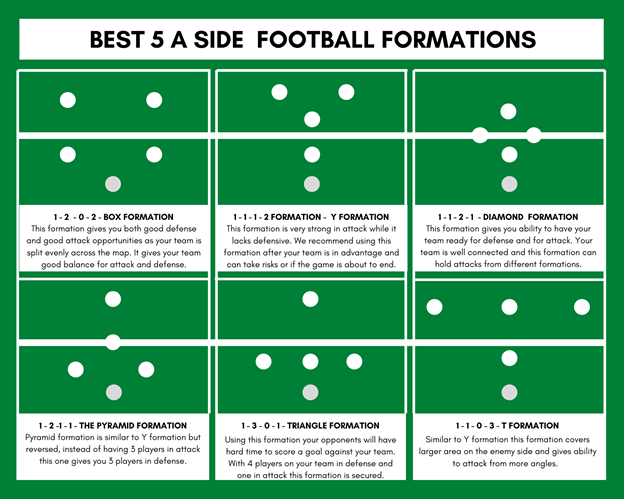Despite the smaller scale of the game when compared to standard 11-aside football, Tactics and Formations are still an essential part of a successful 5-a-side match.
How many times have you gone away from the astro pitch with the tingling thought that the win slipped away because your team wasn’t organised enough?
While the shorter pitch may leave you to rely more on skills than tactics in comparison to full-fledged 11-side games, keeping a good organisation and employing smart tactics can make a world’s difference.
All experienced 5-a-side players will tell you that the fewer people on the field, the more essential tactics become. A well-coordinated formation of unfit older players can overcome 5 tricksters on any given day.
Even if your team is full of skilled players, you should still have a good knowledge of tactics and formations so as not to get embarrassed by the local pub’s circle of mates.
To help you get a hold of the basics on 5-a-side tactics, below, you can find simple tips on the matter to get you and your team in winning form.
The Basics of 5-a-Side
5-a-side has three prominent positions – the goalkeeper, the defender and the forward/attacker. From these three, you can adapt and fit them to form various solutions to create attacking or defending strategies.
Keep one person attacking at all times
The best defence is having a good offence. You might have heard that catch-phrase thrown around, but that’s for a good reason, and whoever said it was right. Placing someone up-field at all times will maintain the pressure on the opposing defence to keep an eye on your teammate. In turn, it also takes pressure from your team and leaves a player focused on finishing the chances you create for a goal.
Keep one person defending at all times
Tight games can often fall for the opposing side because your team didn’t have a person staying on the defensive side. Unexpected counter attacks without a defender will be deadly since the other team will be strolling to the goal if no one tracks back. Leaving a dedicated defender back will have your team less exposed to an incisive opponent run and be the difference in a tight match.
Some of the best teams fall apart because there isn’t at least one person staying back and defending. It doesn’t matter how skilled your strikers are if your opponent can walk in a goal because nobody was willing to trackback. Keeping one person behind also means you’re less likely to be caught off guard on a counterattack. A solitary defender buying the rest of the team some time can mean the difference between victory and defeat.
Find and keep a dedicated goalkeeper
5-a-side is notorious for its fast pace and constant up and down action but sticking your slowest teammate in goal isn’t the solution. When your team is in bad shape, and the rivals have the upper hand, your goalkeeper will be the one between them and a certain goal. Find someone good enough to play goalie that can save your team from defeats while also being reliable to take on this rather unappreciated position.
The 5-a-Side Formations
It’s not at all uncommon to watch teams with either no one attacking or with no one defending. This may seem obvious, but these mistakes will make it very difficult to beat even a modest team, let alone a skilful and experienced group of players.
However, implementing a formation is extremely easy since there are only four outfield players giving your team just a few basic formations to learn effectively:
-
The Square formation
Also known as the “2-up-2-down” or “box formation”, it’s probably the most used formation and can help your team in various situations in the game. The Square is excellent because it provides your team good and easy passing lines while having a balanced distribution on the pitch.
The bad aspect of the Box formation is that it is a rigid structure and can become predictable, especially with more experienced adversaries.
The best way to make it work without having your passes intersected is to continually move after making the pass and have a teammate take that place, thus not letting your rivals sit and waiting to pounce but instead making them run to cover you.
-
The Diamond formation
Commonly known as the 1-2-1, this formation stands out for its flexibility. A diamond formation allows your team to adapt and respond to your rivals’ style of play and then take advantage of their weakness quickly. It is heavily dependent on a good skill set from the defender playing from the back and needs one player being upfront and two others in the middle, who are able to switch between both sides.
These two midfield players act as a balance during the match between defence and attack, adapting to the flow of the game either pushing for goal or tracking back to defend.
Yet, the 1-2-1’s effectiveness depends on those two midfield wing players to be fit to charge up and down the field throughout the game while maintaining tactical awareness; otherwise, the team is left compromised. The most common breach for the diamond formation occurs when the midfielders ignore to fall back on defence or when they fail to support the attacker leaving them alone against the opponent’s defence. Balance is the name of the game when it comes to the diamond, and the midfielders are the key to it.
-
The Y formation
Otherwise known as the 1-1-2, comes a very offensive formation employed to get you that needed goal or goals. This formation will make your attack a constant pressure for the opposing side’s defence and get you closer to scoring with two players pressing high to gain the ball and finish as efficiently as possible.
The clear drawback is that your defence is very vulnerable since a lone defender will have to bear the runs of the rival attackers. Against weaker sides, the Y formation will give your team the upper hand, setting the score to rest very early with goals at early doors but a well-organised adversary can exploit that weak defence formation and your team will concede as well.
However, if the Y formation is the perfect solution for your team when going forward, you can keep it going for the attacking process and revert to a square or diamond to improve your defence on the fly. This will also make it harder for the other team to keep up with your tactics.
-
The Pyramid formation
Known and perceived as the ‘reverse Y’, it carries the opposite idea of the Y formation as this is a defensive-minded formation with a sole purpose of locking your goal from opposing goals.
To set up this formation, position a central midfield player with two defenders flanking him to shield your goalkeeper from shots, limiting the other team’s space and handling the pressure until you can relieve the ball to your lone striker.
The Pyramid formation is an excellent tool when you recognise the other team is more skilled and/or experienced and going head-to-head is a bad idea that will make you concede quickly. Also, when you are in the lead by the skin of your teeth, deploying a reverse-Y is excellent to lock down the result, especially if your attackers are as tired as a worn boot.
This formation still leaves space for a pacey forward who can take advantage of a quick counterattack and stretch your lead. The key player is again a remarkably fit midfield maestro who can absorb the attacking pressure while defending but also set a deadly counter with enough speed to catch the other team on the back foot.
 Don’t think of your formation as a rigid structure
Don’t think of your formation as a rigid structure
Electing the best formation for your 5-a-side team is an important step to start a winning tactic, but if you take it as a rigid formation, it just won’t work.
The fast pace of the game implies that players have to continually move, cover adversaries and fill in for their teammates either defending or attacking. Being adaptable to various positions is an excellent and appreciated trait to play five-a-side.
As an example, if the player that started defending has to make an incisive run to attack the goal, he has to be able to set a good shot just as much as one of the teammates has to be comfortable covering for them.
Each starting position should take into account a broad idea of each players’ strengths and where they should line up, but it does not mean they will just stand in that place and wait for a ball to be chipped in. Everyone on the squad has to carry the responsibility to shift positions and familiarise to different spots on the pitch to work for the team’s success. Drifting out of position is necessary to lose your marker or helping your teammate lose theirs or even both, giving you the ultimate advantage for a great play.
The formations are set in place not to get you from moving but to instil balance, tactic and focus into the match.
Which position is the best for me?
Knowing all the basics of tactics and formations on 5-a-side football might already have given you a good idea on what position suits best your qualities as a player. If not, then you probably already have a preference for a role on the team, either upfront bagging the goals, getting stuck in on a defending position or sprinting up and down by the wings. So, whatever floats your boat really, whether where you perform best or most importantly, where you enjoy playing the most. Also, a great idea to get the hang of where you should be playing is to ask teammates where they think you’re best suited in the pitch.
Nevertheless, the key part of a winning 5-a-side team is not the skill or preference of individual players in certain positions but the willingness in every element of the squad to cover teammates and adapt to other positions when the play so requires.
Try different positions during the training sessions and throughout the season to ensure you are ready to fill in when your teammates are out of shape. In no time you will be a versatile player that can be relied on and the results will certainly show it.
If you’re thinking of getting some playtime on your position or try a new one along with setting up tactics and formations with your stellar team, book a pitch reservation at AstroPark.
Practice makes perfect, and there is no better place to get the ball rolling than on our excellent all-weather facilities, so what are you waiting for? Give us a call or book your pitch online here.

